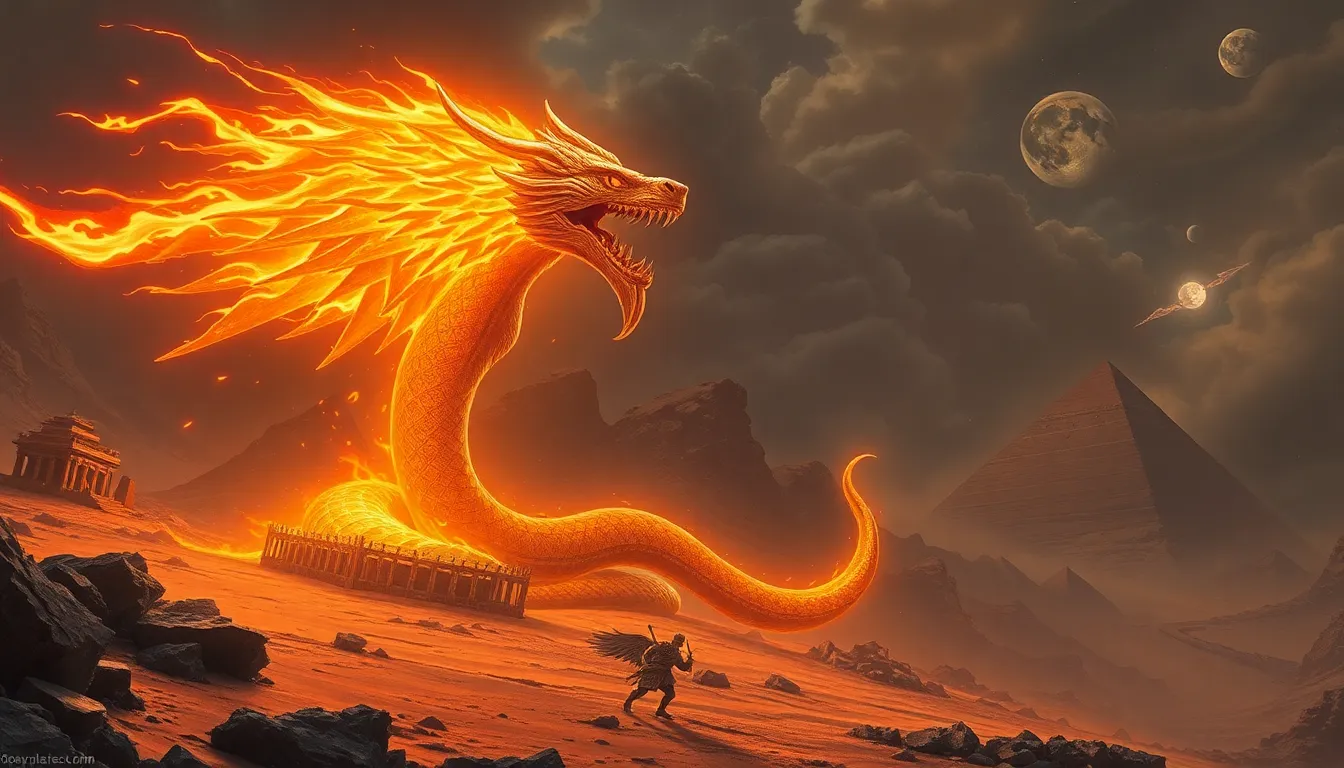The Tale of the Cosmic Serpent: Apep and the Battle for Order
I. Introduction
Apep, known as Apophis in Greek, holds a significant position in ancient Egyptian mythology as the personification of chaos and destruction. This cosmic serpent embodies the eternal struggle between chaos and order, a central theme that permeates Egyptian cosmology. The mythology surrounding Apep serves to illustrate the delicate balance that the ancient Egyptians believed was essential for the maintenance of the universe.
This article aims to delve into the origins of Apep, the duality of order and chaos represented by Ma’at and Isfet, and the eternal battle between Apep and the sun god Ra. Additionally, we will explore the roles of other deities and humans in this conflict, the symbolism of Apep in art and literature, and his legacy in modern culture.
II. The Origins of Apep
Apep’s creation is deeply rooted in Egyptian cosmology. It is said that he was born from the primordial chaos, known as Nun, which existed before the creation of the world. Apep is often depicted as a massive serpent, symbolizing the dangers that lurk in the darkness and the unknown.
The serpent has long been a symbol of danger and chaos in various ancient cultures, representing both fear and fascination. In Egyptian mythology, Apep’s existence is a constant reminder of the ever-present threat of chaos that challenges the order established by the gods.
Apep plays a crucial role in the myth of creation, where his existence is juxtaposed against the gods who seek to maintain balance in the universe. His presence signifies the struggle that must be faced to uphold the principles of Ma’at, the concept of truth, balance, and cosmic order.
III. The Duality of Order and Chaos
In ancient Egyptian thought, the concepts of Ma’at (order) and Isfet (chaos) are fundamental. Ma’at represents truth, justice, and harmony in the universe, while Isfet embodies disorder, violence, and chaos.
Apep is the embodiment of Isfet, constantly seeking to disrupt the order established by the gods. This duality highlights the importance of maintaining cosmic order in Egyptian belief systems, as the balance between Ma’at and Isfet is vital for the survival of the world.
IV. The Eternal Battle: Apep vs. Ra
Ra, the sun god, is one of the most significant deities in Egyptian mythology, revered as the protector of order and light. Each day, Ra embarks on a journey across the sky, symbolizing the triumph of order over chaos.
During his nightly passage through the underworld, Ra encounters Apep, who lies in wait to devour the sun. This confrontation represents the eternal struggle between light and darkness, life and death. Key myths illustrate their battles:
- In one myth, Ra is said to defeat Apep by calling upon the power of other gods and using magical spells.
- Another narrative describes how Ra’s daughter, Sekhmet, aids him in this struggle, showcasing the collaborative efforts of the deities against chaos.
V. The Role of Deities and Humans in the Conflict
Beyond Ra, other deities also play vital roles in the battle against Apep. Set, the god of chaos and storms, is often depicted as a rival of Apep, and Horus, the sky god, is seen as a protector against the forces of chaos.
The ancient Egyptians believed that human rituals and prayers were essential in combating chaos. These practices include:
- Daily rituals performed in temples to honor the gods and ensure their protection.
- Funerary practices designed to aid the deceased in their journey through the afterlife, combating the influence of Apep.
- Amulets and charms inscribed with spells to ward off chaos and ensure safety from Apep’s grasp.
VI. Symbolism of Apep in Art and Literature
Apep is depicted in various forms of ancient Egyptian art, often as a colossal serpent or dragon-like creature. These representations serve as a visual reminder of the chaos that threatens the order of the universe.
Literary references to Apep can be found in sacred texts, including the “Book of the Dead,” where he is portrayed as a formidable adversary to the sun god Ra. These texts emphasize the importance of overcoming chaos to achieve eternal life and order.
Apep’s influence extends beyond ancient Egypt, inspiring later cultural interpretations of chaos and disorder in various literary works and artistic expressions throughout history.
VII. The Legacy of Apep in Modern Culture
Apep’s impact is still felt in contemporary interpretations of mythology, where themes of chaos versus order resonate with modern audiences. This struggle is reflected in various aspects of today’s world, such as:
- Literature exploring the complexities of human nature and the balance of good and evil.
- Film and media that depict epic battles between forces of order and chaos, drawing parallels to Apep’s story.
- Modern artistic interpretations that reflect the ongoing relevance of these ancient themes in contemporary society.
VIII. Conclusion
Apep’s significance in the cosmic struggle between chaos and order remains a powerful narrative in ancient Egyptian mythology. His tale serves as a reminder of the enduring themes of chaos and order that are integral to human existence.
As we reflect on Apep’s legacy, we find that the battle between these opposing forces continues to resonate in our lives today. The story of Apep not only enriches our understanding of ancient beliefs but also encourages us to consider our own struggles with chaos and the importance of striving for order in a complex world.




